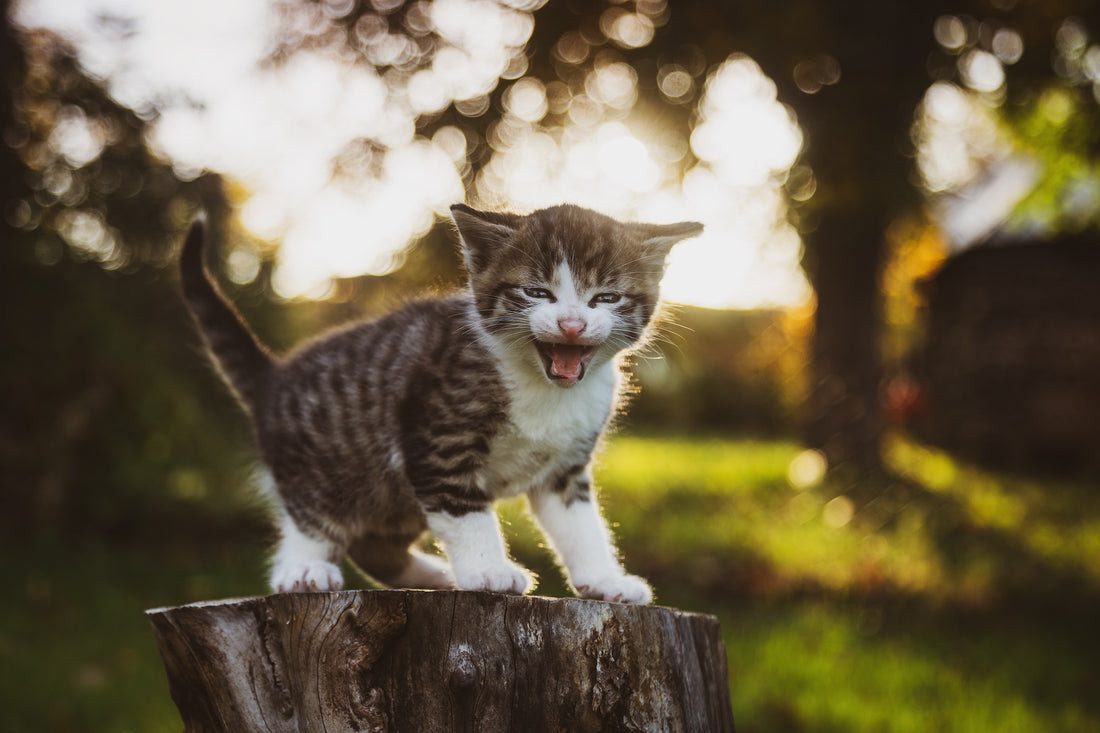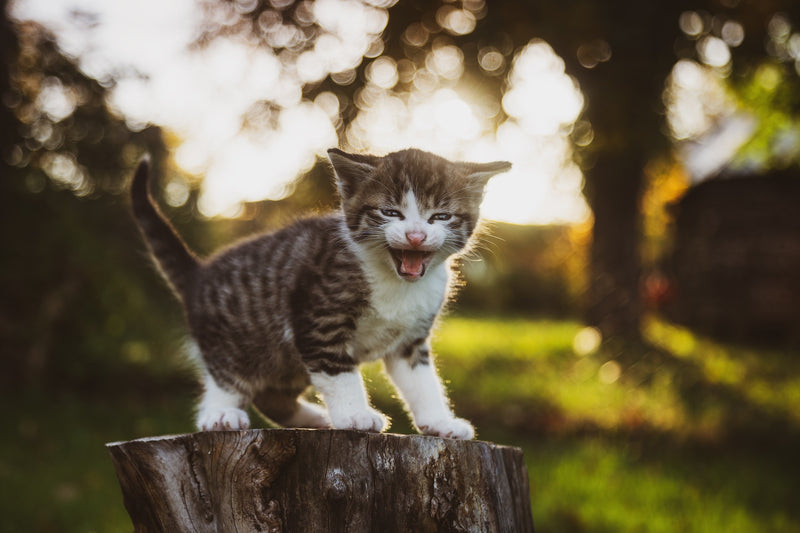Cats are playful, intelligent, and affectionate house pets. They take up less space and generally require less attention than dogs, and they can be trained to get along extremely well in most households. But getting your first new kitten can be overwhelming.
There are so many questions to ask, so many things to acquire, and so many ways to prepare in order to make your kitten’s introduction into their new home as smooth as possible. Who knew getting a little kitten would be so involved?
If you’re feeling the new kitten overwhelm, don’t worry. We can help get your kitten up for the best start to life possible!
The Early Days
Before your kitten sets paw in your house, you have a little work to do—starting with cat-proofing your home.
This means simply ensuring that there are no easily accessible hazards, such as open windows or toxic plants that your new kitten can be tempted to investigate. Your kitten's natural curiosity can get them in trouble. So before you let them have the run of the house, spend a few minutes removing dangerous curiosities like smelly poisons or chemicals, fragile wine glasses perched precariously on ledges, bits and pieces of rubber that can get stuck in a throat, and food items that a kitten probably shouldn’t eat.
Once your home is relatively safe, begin introducing your kitten to their new kingdom.
First Interactions
Be aware that your kitten may be skittish and aloof at first. Cats are very reactive predators and changes in their environment are stressful to them. They will often take several days or weeks to adjust to new things like new people, furniture, or food. After your new cat or kitten has been brought home and appears comfortable in their new surroundings, they will begin interacting more with you and their new family members.
If you already have a cat, make sure they’re healthy and up to date on their vaccinations. You’ll want to introduce the new kitten slowly with short introduction periods. Letting them smell one another through a closed door is a great way to go about this initial meeting. While at first there may be hissing, don’t be too concerned just yet—cats will often work out their differences to become best friends. They just need time. And maybe a calming pheromone spray.
Speaking of keeping things calm, make sure that your new kitty has a quiet, safe place (such as a cat tree or enclosed bed) to get away from people and other pets if they feel like they need to. Inescapable chaos is not good for a kitten's development. Some pet parents swear by the effectiveness of natural pheromone sprays or calming aides to minimize the stress of a new environment.
Housing
Setting up an environment for a new kitten is fairly simple. They’ll need a place to sleep, stimulating activities to help them develop, and a comfortable place to use the litter box
Let’s talk about litter
The most important thing to consider when picking out a litter box is its size. You should choose a litter box that’s large enough for the cat to fit comfortably inside with ample room for them to turn and dig. Be aware that kittens less than eight weeks old may be too small to use an adult-sized litter box. Try to place your cat’s box somewhere quiet in the house where the cat will not be scared or bothered while using the box.
If you are a multi-cat household, pay special attention to how your feline friends are interacting around the box. Some cats have no problem sharing a litter box, but many would throw a fit at the mere idea of sharing. Because of this, it’s a good idea (and mostly like healthier for everyone involved) to provide at least as many boxes as there are cats living in the house. Be sure to remove solid waste daily and change the litter out completely as needed. For best odor control, replace whatever amount of litter you remove from the box as you go.

After litter, toys and scratchers are the next items to consider.
Toys are essential for mental stimulation and development. They are also helpful to you when training your cat not to scratch and chew on your things. The wider the variety of available toys and scratching items you offer, the better for your cat. Choose toys that your cat can play with by themselves and interactive toys that you can use to engage them. But be certain that each toy is not so small that it can be swallowed.
Cats need to scratch things to keep their claws healthy. Always provide them with an appropriate cat scratcher toy or post. We recommend a cat scratch tower so that your cat has a safe place to retreat to when stressed and so that you can train your cat to scratch the tower – and not your furniture.
Finally, a place to sleep
A bed is important for your cat to feel like they have their own safe and warm sleeping area—even if they choose to sleep elsewhere sometimes. Some people train their cats to sleep only on their own beds, and some owners prefer to have several cat beds throughout the home. If you are keeping your cat in a cooler area of the home, consider a warming bed.
Diet
Especially early on, your cat will require a specific diet that will give them enough nutrients to grow at a healthy rate. Careful attention to ingredients and critical nutrient levels are the keys to helping you choose a good, quality cat food.
The protein in a cat or kitten diet should be around 40% and should be animal-based protein, not derived from grains or by-products. This is important because, as obligate carnivores, your cats digestive system needs high amounts of animal protein and minimal carbohydrates to function properly. Additionally, your kitten’s entire physiology is designed to eat small prey animals that would be approximately 80% moisture.
Because of their biological dietary needs, your kitten will do best on canned, rehydrated, or raw food diets that match the required protein and moisture content. Cats are designed to get their daily moisture through food intake and are often unaware of feeling thirsty until they are dangerously dehydrated, which can lead to urinary tract and kidney issues later in life. Choosing a food like what we mentioned above is the simplest way to mitigate these health issues down the road.

Cleaning & Health
Unlike dogs who seem to thrive on rolling in mud and compete for who can make the bigger mess, cats tend to be very clean pets. However, you still have a roll to play in making sure they stay clean and healthy as your kitten grows up.
Basic cleanliness includes keeping your kitten’s bedding, play areas, and litter box clean. Just doing this is a good way to make infections and infestations much less likely. Additionally, you should keep your new kitten away from areas where non-resident pets are (public parks, etc.) until they have finished all of their immunization requirements. You can also cut down on those nasty hairballs by regularly brushing and grooming your kitten.
Not many people consider their cat’s dental health—but healthy teeth are absolutely vital for your kitten's health. It’s a good idea to get your kitten used to having their teeth brushed can also help avoid dental issues later on. Cats over the age of three should start having annual teeth cleanings by a veterinarian to avoid gingivitis.
Ask your vet for other health recommendations as soon as possible. The sooner your kitten can see a vet, the better they can get set up for a thriving and healthy life.
Recommended Supplies
You’ll need everything from the basics like food and water bowls, to some things you might not have thought about like a brush or stain and odor remover. It’s a lot to keep track of. That’s why we put together this helpful new kitten checklist!

Congratulations on your new kitten! We get it, new kitten life can be overwhelming. But if you follow these basic guidelines, you’ll make it through the early days and come out of them with a well-behaved, healthy, loving cat.
Thank you for taking the time to read our article on what to do when you get a new kitten! If you have any questions, we're always happy to help! Feel free to give us a call, shoot us an email, or stop by your local Kahoots Pet store.



